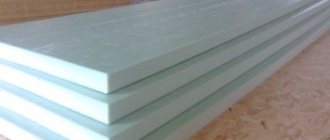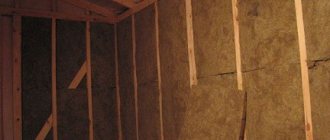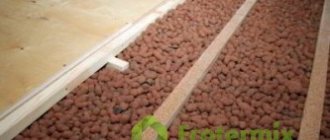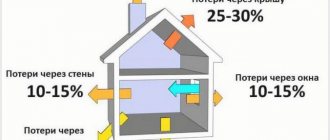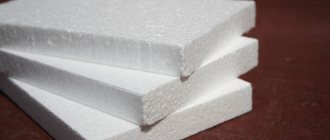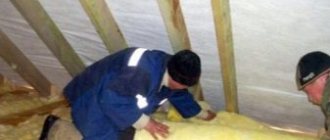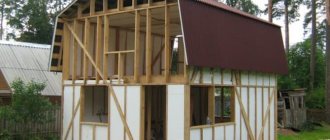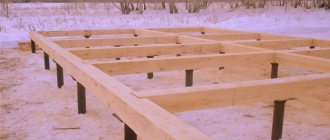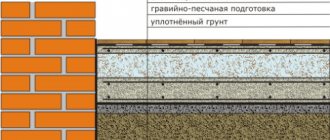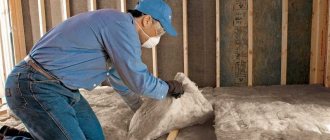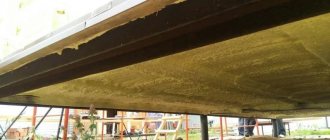The use of penoplex is the most effective method of insulating structures. When carrying out work using this material, no special skills are required, so you can act independently. This product is excellent as a heat insulator for the floors of houses, apartments and baths, as well as balconies and loggias.
Floor insulation in a wooden house with penoplex is also carried out. Most often, a coating or concrete screed is laid on top of the foam layer. Penoplex floor insulation is a common technology for thermal insulation of floor coverings.
What is penoplex?
Penoplex, what is it? Penoplex is a modern material, it is based on polystyrene, which is foamed using technological processing, and unlike its “relative” foam, it consists of a homogeneous structure, and is also more dense and elastic.
This material is in high demand on the building materials market due to its excellent thermal insulation properties. Unlike polystyrene foam, it is more durable, and at the same time also waterproof. Thanks to these properties, it is used for thermal insulation work in any premises.
The structure of penoplex allows it to retain air, so it is always warm, this expands its scope of application in both heated and unheated buildings. Good results in the use of this material have been achieved when insulating the floors of balconies and loggias, as well as bathhouses and the lower floors of houses and apartments. Many experts advise installing penoplex when installing a “warm floor”.
Characteristics of penoplex:
- thickness;
- density;
- flammability.
The use of a heat insulator with certain characteristics depends on the place of application and purpose. When used to increase the thermal insulation properties of the floor, it is better to use penoplex with a greater thickness, and in some cases you can lay one layer of insulation on top of another.
The joints of the lower level sheets did not coincide with the joints of the upper layer.
Some cases show that layers of waterproofing can be glued together using special glue. Using these provisions will help create the most effective thermal insulation layer.
Very often, penoplex material is used in the construction of various objects; it is excellent for thermal insulation of floors installed directly on the ground or reinforced concrete slab, then the coating used as a floor is laid directly on it.
Some people use this product as an insulator in the construction of upper floors and various attics, which is not practical, since a material with lower thermal conductivity characteristics and, consequently, a lower price is quite suitable for these purposes.
The most appropriate use of penoplex is in the following cases:
- insulation of the loggia;
- thermal insulation of the balcony;
- installation of bath floor;
- insulation of various types of floors in a private house or cottage;
- installation of "warm floors".
How to insulate a floor with penoplex yourself. Use the following tips.
Always strictly adhere to the instructions for laying penoplex, otherwise condensation will collect and the wind will “walk” in the empty spaces. To prevent this from happening, it is important to clearly fit one sheet to another, avoiding distortions and tilts. Penoplex flooring is successfully used on soil, concrete and wooden bases.
How to insulate a floor with penoplex?
When is it advisable to use penoplex?
Penoplex (extruded polystyrene foam) differs from other most common thermal insulation materials used for floor insulation, such as polystyrene foam (regular polystyrene foam) or mineral wool in that it has a higher density and rigidity of the slabs, and it does not absorb or allow water to pass through. But, on the other hand, it costs 1.5-2 times more than them and, at the same time, does not have the best thermal insulation properties. Based on this, it makes sense to use penoplex in cases where it is necessary for the insulation to easily withstand mechanical loads, without constructing a stiffening frame.
Extruded polystyrene foam is most often used for insulating floors laid on the ground or on a concrete base with direct laying of the floor covering on it. Typically this is laminate, ceramic tile or linoleum. It is also advisable to use it as thermal insulation when installing heated floors, regardless of their type.
Penoplex insulation of a wooden floor laid on wooden joists (beams) is less rational, since it can easily be done with cheaper insulation materials: the same ordinary polystyrene foam (foam) or mineral wool. This is explained by the fact that in this case, as a rule, the insulation simply fills the space between the lags (beams) and is not subject to mechanical stress. And its moisture resistance is also not of great importance here, since wooden structures must be carefully waterproofed anyway.
Using penoplex directly on the ground
Firstly, it is necessary to level the ground that will be used as a base, and the distance to the floor should be at least fifty centimeters.
The second step is to fill the space with expanded clay, sand or gravel to a height of up to forty centimeters. In this case, you should make sure that the horizontal position is maintained.
The third step is laying penoplex, but at the beginning, you should check the thermal insulation material for unevenness and chips; if found, they should be removed. The material must be at least five centimeters thick. When laying the sheets, press them tightly against each other, without creating a gap; the joints are glued with special tape so that moisture does not get into them.
The edges of the building are fenced with sheets of roofing material or polyethylene, the top of the foam is also covered with these materials, then a layer of cement and metal mesh is mounted on them to strengthen it, while the thickness of the screed should be five centimeters.
Remember that the screed must be strictly horizontal, otherwise you may encounter serious difficulties when laying the flooring.
What type of floor can be used:
- parquet board;
- laminate;
- linoleum;
- any type of ceramic tile;
- polymer coating;
- wooden boards.
Might be interesting
Thermal insulation
How to insulate a roof from the inside and not make mistakes?
Thermal insulation
Roofing and drainage: heating rules
Thermal insulation
Insulated Swedish stove: pros and cons
Thermal insulation
Penoizol: self-production
Installing a floor in a bathhouse has its own specific features. So it is necessary to insulate the walls from the side flush with the floor, the concrete screed is installed at a certain angle, this is necessary for the unhindered flow of water, while the drain must also be isolated from air from the outside.
Sanded boards are used as flooring in the baths; they are installed on logs in increments of fifty centimeters. When installing the floor in a bathhouse, the boards are laid with a gap of 5 millimeters to allow water to drain.
Advantages and disadvantages
Before choosing the material being described, you should learn about its pros and cons. The material has several advantages:
But this insulation also has disadvantages. An example is the fear of sunlight. Because of this, you have to store penoplex in a dark place. Also, when purchasing, you should remember about the high cost. The insulation does not burn, but melts well at a significant increase in temperature. That is why it should not be used in rooms where fire may occur.
Installation of insulation on a finished base
Before you begin installing the insulation on a ready-made base, you need to get rid of the old floor. Floorboards, parquet, laminate, tiles or any other floor covering must be completely removed, since if this is not done, then all the defects of the previous floor will smoothly migrate to the new one. After dismantling, you should carefully examine the concrete surface for unevenness, cracks or potholes.
For leveling, you can use a special self-leveling solution. Then we proceed to the actual installation of the insulation. Laying penoplex on the floor to a concrete surface is carried out using a special glue that will not corrode the insulation, then a layer of waterproofing is installed and cement is applied.
Insulating the floor of a loggia or balcony
Carrying out this installation work does not require special tools or special skills; any owner can do this work; you just need to have patience and preparation. Thermal insulation is carried out in the same manner as insulating a concrete floor with penoplex.
First, the old floor covering is removed, then the concrete screed is leveled and after that they begin to install the insulation, in this case penoplex. It is important to remember that cement screed work is always carried out in warm weather.
If your loggia or balcony is not the first from the ground and the loggias of the neighbors living below you are insulated, then you do not need to use thick penoplex. A material with a height of three centimeters is suitable, and the cement screed on the penoplex should also be three centimeters.
If the balcony area is not too large, then sheets of any hard waterproof material can be used as a cement screed.
When the balcony or loggia is completely glazed, then fiberboard sheets can be installed on the concrete floor, and then the insulation and a layer of cement screed can be installed, and then the floor covering.
Penoplex is also successfully used to insulate loggia walls, using a material of small thickness. But when your balcony is the first from the ground, then you need to think about using penoplex with a thickness of five centimeters.
Installation of insulation when installing “warm floors”
If at the same time you want to install a “warm floor”, then penoplex for a warm floor is mounted both directly into a cement screed and into a layer of insulation in which the necessary holes are cut.
After checking the operation of the electrical part of the elements or water pipes, they begin laying the cement screed; after the final hardening of the latter, they begin laying the floor covering.
Penoplex is installed under the floor screed. The heated floor is laid on penoplex. Installing a heated floor on penoplex is not difficult. Laying penoplex for water heated floors (water heating) is no different. Place the slabs of material carefully under the warm floor.
Features of installing penoplex on a wooden base
Insulation of a wooden floor with penoplex: here the insulation sheets are laid directly on boards or sheets of plywood, fiberboard, that is, the material that is used as the so-called “subfloor”, but in this case it is important that the surface is flat and the foam sheets are joined without gaps.
The insulation is nailed to the surface with special devices that will not allow them to “play” and create air pockets, which in the future will lead to peeling of the foam layer. When the entire surface of the wooden flooring is completely covered, begin installing the floorboards; they are nailed directly to the wooden joists.
This is how the floor is insulated with penoplex (penoplex) if the base is made of wood. Insulating the floor in a wooden house is not difficult.
Do-it-yourself floor insulation with penoplex under screed
Insulating floors in apartments or private houses is a very important task, the solution of which must be approached with particular care. Many people have no idea what material will help make the floor not only warm, but also durable. There are a huge number of materials for this - mineral wool, expanded clay, polyurethane foam, foil insulation and penoplex.
Of this variety, special attention should be paid to penoplex. After all, this material has the best characteristics - excellent thermal insulation and sound insulation properties, low weight, resistance to temperature changes, high moisture resistance, resistant to fungi and mold, and much more. His qualities can be listed endlessly.
But how to insulate the floor with Penoplex slabs yourself? Everything is very simple! The main thing is to do everything step by step.
Bottom line
Let's summarize and consider additional tips. Using penoplex-35 is the best option for thermal insulation of your floor. This material has “poor contact” with substances such as gasoline, ether, acetone, kerosene and others. Bright sunlight should not fall on the foam boards.
If you store the material outdoors, you should make a barrier for the sun's rays to prevent them from entering. It is imperative to make a cement screed, and only then apply the floor covering. The cement screed ensures uniform load distribution.
Floor screed with penoplex is the best option. Insulating the floor with penoplex without a screed does not give the desired result. Penoplex screeds have heating elements.
A self-leveling floor on penoplex is installed if the material has a thickness of 20 millimeters. Extruded polystyrene foam is the most common and durable material. Do not forget to inspect the floor slabs and make sure that they are not damaged in any way.
As we have seen, absolutely anyone can carry out floor insulation with penoplex. It is only necessary to take into account some features of the base on which the penoplex will be installed. Do-it-yourself insulation material for the floor under the screed is a necessary technology.
Reviews about Penoplex insulation
“I have long wanted to insulate the floor in a country house in the country. I was looking for the most suitable materials. I wanted to buy something really effective. Here in one store I saw the slabs, I was immediately interested and the vessels were of really good quality according to their characteristics.
And the seller then praised them so much and assured that they would not only keep the house warm, but would also last a long time. I thought about it and decided it was really worth a try. I installed them myself, since I am a builder by profession. 6 years have already passed, and they are like new and have not deformed or deteriorated. And the house became much warmer"
Sergey Diveev, Ekaterinburg
“About 2 years ago, my husband completely changed the sex, made a new screed. And immediately we had the question of how to insulate the floor. Since we live in a private house, with the onset of cold weather the floors become very cold. We have been looking for material for floor insulation for quite a long time.
Once on the Internet I saw a complete description of the penoplex material, and I was immediately attracted by the fact that there were a lot of positive reviews about it. We immediately purchased it and installed it. We haven't had any worries for two years now. The floors are always warm, and the material is like new!”
Elena Krasilnikova, Krasnodar
“I always wanted to have insulated floors. I live in a multi-storey building on the 3rd floor. Even though it’s warm here, in winter the floors are sometimes very cold, and this causes discomfort. It took me very little time to find good insulation, since a friend was doing renovations and insulating his floors with penoplex. I also decided to insulate the floors with this material. Yes, really good insulation. The floors are always warm. Now they don’t even care about severe frosts!”
Alexey Sidorenko, Saratov
“For 5 years now, penoplex insulation has been installed on the floors in our house. We have never regretted choosing this particular insulation. It is very warm and durable. During this time, it did not lose its qualities and was not deformed. If you still don’t know what material to choose for insulating your floors, then definitely choose Penoplex insulation!”
Svetlana Leonova, Moscow
“Two years ago I replaced the floors in my country house, completely screeded and insulated it. For insulation, I didn’t hesitate to use foam boards. I have long heard about the excellent qualities of this material. I have already changed the linoleum twice, and the penoplex is like new. Has not deteriorated or become deformed. Besides that, the house is always warm and cozy!”
Vitaly Sivtsov, Samara
Penoplex is a really good insulation material that is ideal for floors. If everything is done correctly during its installation and all preparatory work is followed, then the insulation will perfectly retain the heat of the floors.
Also, do not forget about waterproofing and reinforcement of floors; the further service life of the material will depend on this.
